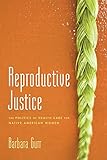Reproductive Justice : The Politics of Health Care for Native American Women / Barbara Gurr.
Material type: TextPublisher: New Brunswick, NJ : Rutgers University Press, [2014]Copyright date: ©2015Description: 1 online resource (216 p.)Content type:
TextPublisher: New Brunswick, NJ : Rutgers University Press, [2014]Copyright date: ©2015Description: 1 online resource (216 p.)Content type: - 9780813564692
- 9780813564708
- Healthcare disparities -- United States
- Human reproduction -- Law and legislation
- Indian women -- Health and hygiene -- United States
- Indians of North America -- Health and hygiene -- United States
- Native women -- Medical care -- United States
- Reproductive health services -- United States
- Reproductive health -- United States
- Reproductive rights -- United States
- SOCIAL SCIENCE / General
- 362.1981 23
- KIE1380 .G87 2015
- RG121 .G87 2015eb
- online - DeGruyter
- Issued also in print.
| Item type | Current library | Call number | URL | Status | Notes | Barcode | |
|---|---|---|---|---|---|---|---|
 eBook
eBook
|
Biblioteca "Angelicum" Pont. Univ. S.Tommaso d'Aquino Nuvola online | online - DeGruyter (Browse shelf(Opens below)) | Online access | Not for loan (Accesso limitato) | Accesso per gli utenti autorizzati / Access for authorized users | (dgr)9780813564708 |
Browsing Biblioteca "Angelicum" Pont. Univ. S.Tommaso d'Aquino shelves, Shelving location: Nuvola online Close shelf browser (Hides shelf browser)

|

|

|

|

|

|

|
||
| online - DeGruyter Disaster! : Stories of Destruction and Death in Nineteenth-Century New Jersey / | online - DeGruyter Salvadoran Imaginaries : Mediated Identities and Cultures of Consumption / | online - DeGruyter American Hybrid Poetics : Gender, Mass Culture, and Form / | online - DeGruyter Reproductive Justice : The Politics of Health Care for Native American Women / | online - DeGruyter Raised at Rutgers : A President's Story / | online - DeGruyter Holocaust : An American Understanding / | online - DeGruyter Misconception : Social Class and Infertility in America / |
Frontmatter -- Contents -- Acknowledgments -- Commonly Used Acronyms -- Part I. Introductions: The Stories We Tell and Why -- 1. Introducing Our Relatives and Introducing the Story -- 2. Stories from Indian Country -- 3. Whose Rights? Whose Justice?: Reproductive Oppression, Reproductive Justice, and the Reproductive Body -- Part II. Tracing the Ruling Relations: Health Care, the Reproductive Body, and Native America -- 4. The Ruling Relations of Reproductive Health Care -- 5. Producing the Double Discourse: The History and Politics of Native-US Relations and Imperialist Medicine -- 6. "To Uphold the Federal Government's Obligations . . . and to Honor and Protect": The Double Discourse of the Indian Health Service -- Part III. Consequences of the Double Discourse: Native Women's Experiences with the Indian Health Service -- 7. Resistance and Accommodation: Negotiating Prenatal Care and Childbirth -- 8. One in Three: Violence against Native Women -- 9. Genocidal Consequences: Contraception, Sterilization, and Abortion in the Fourth-World Context -- Part IV. Reproductive Justice for Native Women -- 10. Community Knowledge, Community Capital, and Cultural Safety -- 11. Conclusions: Native Women in the Center -- Appendix A: Methods and Methodologies -- Appendix B: A Brief Chronology of Federal Actions -- References -- Index -- About the Author
restricted access online access with authorization star
http://purl.org/coar/access_right/c_16ec
In Reproductive Justice, sociologist Barbara Gurr provides the first analysis of Native American women's reproductive healthcare and offers a sustained consideration of the movement for reproductive justice in the United States. The book examines the reproductive healthcare experiences on Pine Ridge Reservation, home of the Oglala Lakota Nation in South Dakota-where Gurr herself lived for more than a year. Gurr paints an insightful portrait of the Indian Health Service (IHS)-the federal agency tasked with providing culturally appropriate, adequate healthcare to Native Americans-shedding much-needed light on Native American women's efforts to obtain prenatal care, access to contraception, abortion services, and access to care after sexual assault. Reproductive Justice goes beyond this local story to look more broadly at how race, gender, sex, sexuality, class, and nation inform the ways in which the government understands reproductive healthcare and organizes the delivery of this care. It reveals why the basic experience of reproductive healthcare for most Americans is so different-and better-than for Native American women in general, and women in reservation communities particularly. Finally, Gurr outlines the strengths that these communities can bring to the creation of their own reproductive justice, and considers the role of IHS in fostering these strengths as it moves forward in partnership with Native nations. Reproductive Justice offers a respectful and informed analysis of the stories Native American women have to tell about their bodies, their lives, and their communities.
Issued also in print.
Mode of access: Internet via World Wide Web.
In English.
Description based on online resource; title from PDF title page (publisher's Web site, viewed 30. Aug 2021)


